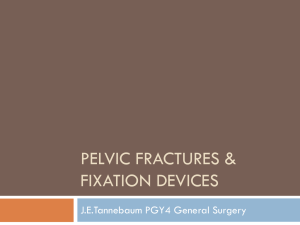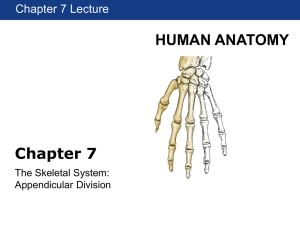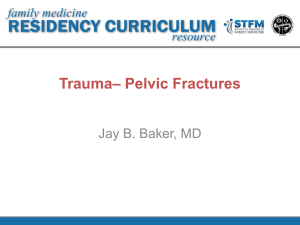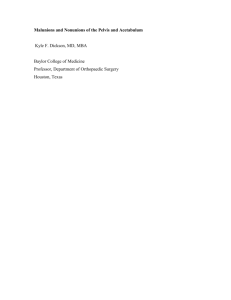Emergency Stabilization of Pelvic Fractures
advertisement
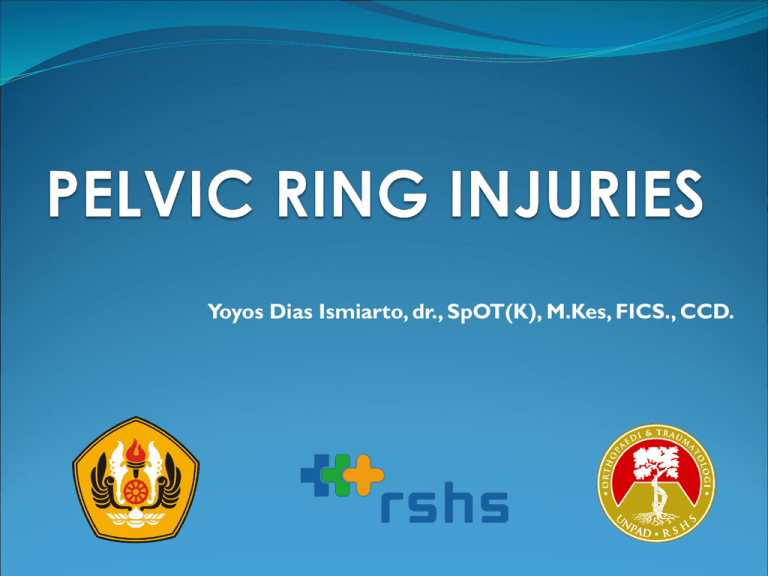
Yoyos Dias Ismiarto, dr., SpOT(K), M.Kes, FICS., CCD. Epidemiology • The overall incidence of pelvic ring injuries is estimated at about 3% of all fractures (AO). – Among the polytrauma patients, the incidence has risen to 25%. – Mortality is about 6 - 50%. – 39% due to bleeding (early). – 30% due to sepsis & multi-organ failure (late). Anatomy of Pelvis Pelvis contains one pair of fused bone Each half contains: ilium, pubis, and ischium Joined together in posterior by sacrum Joined in anterior by symphysis pubis Anatomy of Pelvis Ilium Male Pelvis Female Pelvis Sacrum Pubis Ischium Symphysis Pubis Anatomy Around Pelvis Organs near pelvis Parts of digestive system Reproductive organs Bladder and urethra Blood vessels run through and around Right and left iliac arteries from off aorta Right and left iliac veins returning from legs Blood vessels supplying pelvis and tissues around pelvis Function of Pelvis Pelvis bears weight of upper body Balances weight for legs when standing Protect blood vessels and organs Also serves as connection point for numerous leg muscles Common Fractures of Pelvis Pelvic ring fractures Pelvic ring is likely to separate in more than one location Iliac crest fractures Fractures to upper wing of ilium Pelvic Fractures Common mechanisms of pelvic injury result from high energy ex. MVC, significant falls, skiing accident Those at risk for pelvic fractures Growing teens (especially those involved in sports) Elderly patients (osteoporosis) Risks of Pelvic Factures Iliac Crest fracture Typically pelvis still stable Little blood loss Pelvic Ring fracture Internal organ damage Significant blood loss (up to 4 liters) • Hypovolemic shock Unstable pelvis Risk of death (Mortality of 3.4%-42%) Pelvic Ring Stability Stability defined as patient ability to support physiologic load Physiologic load may be sitting, side lying, or standing, as dictated by patient needs else consider as unstable Pelvic Ring Stability Posterior ring integrity is important in transferring load from torso to lower extremities Pelvic Ring Stability Loss of posterior ring integrity leads to instability Loss of anterior ring integrity may contribute to instability, and may be a marker to posterior ring injury Young and burgess classification will guide us for stability issues Young & Burgess Classification Pathology The poor prognosis of pelvic fractures Fracture and vascular injury can cause the formation of hematoma in the pelvis and retroperitoneum 4 liters of blood 90% bleeding venous disruption or cancellous bone 10% bleeding an arterial injury Assessment ATLS Approach Check Stability : Mechanic Haemodynamic Assessment cont. Pelvis specific assessment Check for bruising, deformity, or abrasions Listen/Feel for crepitus Check limb length Assessment cont. Check stability of pelvis (DON’T REPEAT) Apply gentle medial pressure with palms by pressing inward on iliac crests 2) With patient supine, apply gentle posterior pressure by pressing downward on iliac crests 3) Apply gentle downward pressure on pubis to check pelvic ring stability 1) Stability Assessment 1) Medial pressure 2) Posterior iliac pressure 3) Posterior pubis pressure Diagnosis 1. General: abrasion, contusion, hematoma, over bony prominence of pelvis, scrotal, vulvar hematoma. 2. PE 3. X-ray 4. FAST 5. DPL 6. CT Radiographic Evaluation • X-Ray AP view: – Anterior lesions: pubic rami fractures – Symphysis displacement – Sacroiliac joint and sacral fractures – Iliac fractures – L5 transverse process fractures Radiographic Signs of Instability • Broken ‘Ring’ • Symphysis gap > 2.5 cm • Sacroiliac displacement of 5 mm in any plane. • Avulsion of the 5th lumbar transverse process, the lateral border of the sacrum (sacrotuberous ligament), or the ischial spine (sacrospinous ligament). Treatment Treat for life threatening injuries Treat for possible shock Oxygen Intravenous infusion Splinting / Wrap Pain control RAPID TRANSPORT!!! Palients with hemorrhagic shock and unstable pelvic fractures have four potential sources of bloodloss : (1) fractured bone surfaces (2) pelvic venous plexus (3) pelvic arterial injury, and (4) extrapelvic sources. The pelvis should be temporarily stabilized or "closed" using an available commercial compression device or sheet to decrease bleeding. • • In the presence of unstable pelvic ring disruption and a positive abdominal study, stabilization of the pelvis should be undertaken before laparatomy. If hemodynamic stability is not achieved after placement of the external fixator, arteriography should then be performed. Non-Operative Management (haemodinamically stable ) Lateral impaction type injuries with minimal (< 1.5 cm) displacement Pubic rami fractures with no posterior displacement Minimal gapping of pubic symphysis Operative Management Operative indications Pelvic unstable symphysis diastasis > 2.5 cm SI joint displacement > 1 cm sacral fracture with displacement > 1 cm displacement or rotation of hemipelvis open fracture Hemodynamically unstable Operative Management Hemodynamically unstable Reduce pelvic volume : promote blood clot as well as reducing blood volume from inside bleeding Technique First aid : pelvic wrap Next : Ex fix/ C clamp Haemodynamic Status Options for immediate hemorrhage control • Military antishock trousers (MAST): Typically applied in the field. – No impact on survival rate. – Severe complications reported (compartment syndrome, extremity loss) Haemodynamic Status Options for immediate hemorrhage control Pelvic binder (pelvic wrap): • This is wrapped circumferentially around the pelvis. C-Clamp Operative Management Posterior ring structure is important Goal : restoration of anatomy and enough stability to maintain reduction during healing Anterior ring fixation may provide structural protection of posterior fixation Anterior Fixation of Pelvic Posterior Fixation of Pelvic Haemodynamic Status Options for immediate hemorrhage control • Anterior external fixator: – In the acute phase many advocate external fixation as a temporary device to achieve stabilization of the fracture and a positive effect on haemorrhage. External fixation 1. Advantages It helps tamponade bleeding from bone edges . Stabilizing the clots and the bone. Could be done in 20 min. 2. Disadvantages Can’t stop arterial bleeding. Delay the embolization for ongoing arterial hemorrhage. Degrade the quality of CT and angio. Complications • Infection • Thromboembolism • Non-Union • Malunion Summary Pelvic fracture High morbidity and mortality Multiple trauma Team work (ATLS Approach) Check stability (Mechanic and Haemodynamic) Early immobilization Pelvic Wrap Diagnostic tools Definitive treatment



